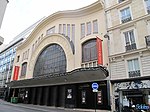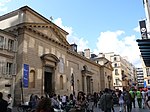Rue Saint-Lazare
Streets in the 8th arrondissement of ParisStreets in the 9th arrondissement of Paris

The Rue Saint-Lazare is a street in the 8th and 9th arrondissements of Paris, France. It starts at 9 Rue Bourdaloue and 1 Rue Notre-Dame-de-Lorette, and ends at Place Gabriel-Péri and Rue de Rome.
Excerpt from the Wikipedia article Rue Saint-Lazare (License: CC BY-SA 3.0, Authors, Images).Rue Saint-Lazare
Rue Saint-Lazare, Paris 9th Arrondissement (Paris)
Geographical coordinates (GPS) Address Nearby Places Show on map
Geographical coordinates (GPS)
| Latitude | Longitude |
|---|---|
| N 48.876062 ° | E 2.330426 ° |
Address
Centre des Finances Publiques
Rue Saint-Lazare
75009 Paris, 9th Arrondissement (Paris)
Ile-de-France, France
Open on Google Maps











